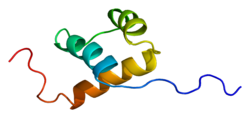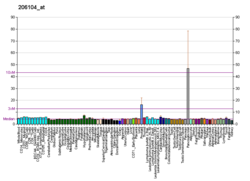ISL1
ISL1인슐린 유전자 증진제 단백질 ISL-1은 인간에게 있어 ISL1 유전자에 의해 암호화된 단백질이다.[5][6]
함수
이 유전자는 두 개의 N-단자 LIM 도메인과 한 개의 C-단자 홈오도메인을 포함하는 전사 인자를 인코딩한다.암호화된 단백질은 췌장 랑게르한스섬의 발생에 중요한 역할을 한다.쥐의 배아에서, 이 유전자의 결핍은 신경관 운동 뉴런 분화를 거치지 못하는 결과를 낳는다.[6]
상호작용
ISL1은 에스트로겐 수용체 알파와 상호작용하는 것으로 나타났다.[7]
심장발달의 역할
ISL1은 우심실과 유출을 포함하는 2차 심장장(SHF)의 심장 조제기에 대한 표식이다.심장이 심하게 변형된 Isl1 녹아웃 생쥐에서 볼 수 있는 생물학적 기능도 가지고 있다.[8]보다 최근에는 심장의 세 가지 주요 세포 유형, 즉 심근 세포, 부드러운 근육, 내피 세포 라인으로 구분할 수 있는 심장 조제 세포 혈통의 표시로 정의되었다.[9][10][11]
일부 집단은 ISL1 세포가 심장 세포의 생성자 역할을 한다는 증거를 발견하지 못했기 때문에 심장 생성자 세포의 표식자로서 ISL1의 유효성에 의문이 제기되었다.[12]게다가, ISL1은 발달 중인 심장의 두 번째 심장장 조제기로 제한되지 않고 심장 신경 파고라는 라벨을 붙이기도 한다.[13]본 논문은 ISL1이 신경 파고와 심근 세포 라인 양쪽의 세포를 나타낼 수 있다는 결론을 내린 2011년 빌킨 그룹의 작업을 지원한다.[14]ISL1 양성 세포가 심장의 3대 세포 유형으로 실제로 분화할 수 있다는 것이 여러 그룹에 의해 입증되었지만, 심혈관 발달에 있어 그 중요성은 여전히 불분명하고 임상적 관련성에 심각한 의문이 제기되었다.
참조
- ^ a b c GRCh38: 앙상블 릴리스 89: ENSG00000016082 - 앙상블, 2017년 5월
- ^ a b c GRCm38: 앙상블 릴리스 89: ENSMUSG000042258 - 앙상블, 2017년 5월
- ^ "Human PubMed Reference:". National Center for Biotechnology Information, U.S. National Library of Medicine.
- ^ "Mouse PubMed Reference:". National Center for Biotechnology Information, U.S. National Library of Medicine.
- ^ Tanizawa, Y.; Riggs, A. C.; Dagogo-Jack, S.; Vaxillaire, M.; Froguel, P.; Liu, L.; Donis-Keller, H.; Permutt, M. A. (1 July 1994). "Isolation of the human LIM/homeodomain gene islet-1 and identification of a simple sequence repeat polymorphism [corrected]". Diabetes. 43 (7): 935–941. doi:10.2337/diabetes.43.7.935.
- ^ a b "Entrez Gene: ISL1 ISL1 transcription factor, LIM/homeodomain, (islet-1)".
- ^ Gay F, Anglade I, Gong Z, Salbert G (October 2000). "The LIM/homeodomain protein islet-1 modulates estrogen receptor functions". Mol. Endocrinol. 14 (10): 1627–48. doi:10.1210/me.14.10.1627. PMID 11043578.
- ^ Cai CL, Liang X, Shi Y, Chu PH, Pfaff SL, Chen J, Evans S (December 2003). "Isl1 identifies a cardiac progenitor population that proliferates prior to differentiation and contributes a majority of cells to the heart". Dev. Cell. 5 (6): 877–89. doi:10.1016/S1534-5807(03)00363-0. PMC 5578462. PMID 14667410.
- ^ Moretti A, Caron L, Nakano A, Lam JT, Bernshausen A, Chen Y, Qyang Y, Bu L, Sasaki M, Martin-Puig S, Sun Y, Evans SM, Laugwitz KL, Chien KR (December 2006). "Multipotent embryonic isl1+ progenitor cells lead to cardiac, smooth muscle, and endothelial cell diversification". Cell. 127 (6): 1151–65. doi:10.1016/j.cell.2006.10.029. PMID 17123592. S2CID 31238870.
- ^ Laugwitz KL, Moretti A, Lam J, Gruber P, Chen Y, Woodard S, Lin LZ, Cai CL, Lu MM, Reth M, Platoshyn O, Yuan JX, Evans S, Chien KR (February 2005). "Postnatal isl1+ cardioblasts enter fully differentiated cardiomyocyte lineages". Nature. 433 (7026): 647–53. Bibcode:2005Natur.433..647L. doi:10.1038/nature03215. PMC 5578466. PMID 15703750.
- ^ Bu L, Jiang X, Martin-Puig S, Caron L, Zhu S, Shao Y, Roberts DJ, Huang PL, Domian IJ, Chien KR (July 2009). "Human ISL1 heart progenitors generate diverse multipotent cardiovascular cell lineages". Nature. 460 (7251): 113–7. Bibcode:2009Natur.460..113B. doi:10.1038/nature08191. PMID 19571884. S2CID 801804.
- ^ Weinberger F, Mehrkens D, Friedrich FW, Stubbendorff M, Hua X, Müller JC, Schrepfer S, Evans SM, Carrier L, Eschenhagen T (May 2012). "Localization of Islet-1-positive cells in the healthy and infarcted adult murine heart". Circ. Res. 110 (10): 1303–10. doi:10.1161/CIRCRESAHA.111.259630. PMC 5559221. PMID 22427341.
- ^ Engleka KA, Manderfield LJ, Brust RD, Li L, Cohen A, Dymecki SM, Epstein JA (March 2012). "Islet1 derivatives in the heart are of both neural crest and second heart field origin". Circ. Res. 110 (7): 922–6. doi:10.1161/CIRCRESAHA.112.266510. PMC 3355870. PMID 22394517.
- ^ Khattar P, Friedrich FW, Bonne G, Carrier L, Eschenhagen T, Evans SM, Schwartz K, Fiszman MY, Vilquin JT (June 2011). "Distinction between two populations of islet-1-positive cells in hearts of different murine strains". Stem Cells Dev. 20 (6): 1043–52. doi:10.1089/scd.2010.0374. PMC 5880329. PMID 20942609.
추가 읽기
- Larsson LI (1999). "On the development of the islets of Langerhans". Microsc. Res. Tech. 43 (4): 284–91. doi:10.1002/(SICI)1097-0029(19981115)43:4<284::AID-JEMT2>3.0.CO;2-0. PMID 9849969.
- Dong J, Asa SL, Drucker DJ (1992). "Islet cell and extrapancreatic expression of the LIM domain homeobox gene isl-1". Mol. Endocrinol. 5 (11): 1633–41. doi:10.1210/mend-5-11-1633. PMID 1685766.
- Riggs AC, Tanizawa Y, Aoki M, Wasson J, Ferrer J, Rabin DU, Vaxillaire M, Froguel P, Permutt MA (1995). "Characterization of the LIM/homeodomain gene islet-1 and single nucleotide screening in NIDDM". Diabetes. 44 (6): 689–94. doi:10.2337/diabetes.44.6.689. PMID 7789634.
- Wang M, Drucker DJ (1994). "The LIM domain homeobox gene isl-1: conservation of human, hamster, and rat complementary deoxyribonucleic acid sequences and expression in cell types of nonneuroendocrine lineage". Endocrinology. 134 (3): 1416–22. doi:10.1210/en.134.3.1416. PMID 7907017.
- Pfaff SL, Mendelsohn M, Stewart CL, Edlund T, Jessell TM (1996). "Requirement for LIM homeobox gene Isl1 in motor neuron generation reveals a motor neuron-dependent step in interneuron differentiation". Cell. 84 (2): 309–20. doi:10.1016/S0092-8674(00)80985-X. PMID 8565076. S2CID 5780554.
- Bonaldo MF, Lennon G, Soares MB (1997). "Normalization and subtraction: two approaches to facilitate gene discovery". Genome Res. 6 (9): 791–806. doi:10.1101/gr.6.9.791. PMID 8889548.
- Ahlgren U, Pfaff SL, Jessell TM, Edlund T, Edlund H (1997). "Independent requirement for ISL1 in formation of pancreatic mesenchyme and islet cells". Nature. 385 (6613): 257–60. Bibcode:1997Natur.385..257A. doi:10.1038/385257a0. PMID 9000074. S2CID 4341596.
- Jurata LW, Pfaff SL, Gill GN (1998). "The nuclear LIM domain interactor NLI mediates homo- and heterodimerization of LIM domain transcription factors". J. Biol. Chem. 273 (6): 3152–7. doi:10.1074/jbc.273.6.3152. PMID 9452425.
- Bach I, Rodriguez-Esteban C, Carrière C, Bhushan A, Krones A, Rose DW, Glass CK, Andersen B, Izpisúa Belmonte JC, Rosenfeld MG (1999). "RLIM inhibits functional activity of LIM homeodomain transcription factors via recruitment of the histone deacetylase complex". Nat. Genet. 22 (4): 394–9. doi:10.1038/11970. PMID 10431247. S2CID 22326394.
- Gay F, Anglade I, Gong Z, Salbert G (2001). "The LIM/homeodomain protein islet-1 modulates estrogen receptor functions". Mol. Endocrinol. 14 (10): 1627–48. doi:10.1210/me.14.10.1627. PMID 11043578.
- Ostendorff HP, Peirano RI, Peters MA, Schlüter A, Bossenz M, Scheffner M, Bach I (2002). "Ubiquitination-dependent cofactor exchange on LIM homeodomain transcription factors". Nature. 416 (6876): 99–103. Bibcode:2002Natur.416...99O. doi:10.1038/416099a. PMID 11882901. S2CID 4426785.
- Holm P, Rydlander B, Luthman H, Kockum I, European Consortium for IDDM Genome Studies (2004). "Interaction and association analysis of a type 1 diabetes susceptibility locus on chromosome 5q11-q13 and the 7q32 chromosomal region in Scandinavian families". Diabetes. 53 (6): 1584–91. doi:10.2337/diabetes.53.6.1584. PMID 15161765.
- Hori Y, Gu X, Xie X, Kim SK (2006). "Differentiation of insulin-producing cells from human neural progenitor cells". PLOS Med. 2 (4): e103. doi:10.1371/journal.pmed.0020103. PMC 1087208. PMID 15839736.
- Takeuchi JK, Mileikovskaia M, Koshiba-Takeuchi K, Heidt AB, Mori AD, Arruda EP, Gertsenstein M, Georges R, Davidson L, Mo R, Hui CC, Henkelman RM, Nemer M, Black BL, Nagy A, Bruneau BG (2005). "Tbx20 dose-dependently regulates transcription factor networks required for mouse heart and motoneuron development". Development. 132 (10): 2463–74. doi:10.1242/dev.01827. PMID 15843409.
- Peng SY, Wang WP, Meng J, Li T, Zhang H, Li YM, Chen P, Ma KT, Zhou CY (2006). "ISL1 physically interacts with BETA2 to promote insulin gene transcriptional synergy in non-beta cells". Biochim. Biophys. Acta. 1731 (3): 154–9. doi:10.1016/j.bbaexp.2005.08.013. PMID 16321656.
외부 링크
- ISL1+단백질,+인간 미국 국립 의학 도서관의 의학 과목 제목(MSH)
이 기사는 공공영역에 있는 미국 국립 의학 도서관의 텍스트를 통합하고 있다.









